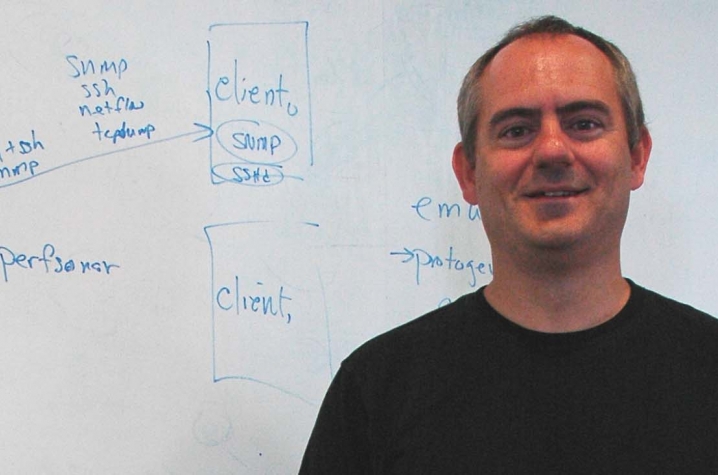Sneaking Open the Secrets of Millennia Past
LEXINGTON, Ky. (Oct. 7, 2009) -- When he got back from Europe, Brent Seales had an old friend waiting for him.
"That's Rudy," Seales said, nodding to the figure that stood in a corner of Seales' office in the University of Kentucky Center for Visualization and Virtual Environments (Vis Center).
"He's a medical mannequin," Seales added. "One of my grad students must have put him here while I was in Paris."
Ah, yes, Paris, the City of Lights, where Seales, a UK computer science professor and director of the Vis Center, and four members of his team spent four weeks this summer to unlock the secrets contained in several fragile, ancient scrolls and manuscripts.
Seales and his team -- Lowell Pike, information technology support; Steve Bailey, videographer; and Ryan Baumann and Matt Field, technical assistants -- used special equipment to perform scans of the carbonized papyri being maintained at the Institut de France after their discovery in the Italian ruins of Herculaneum, which had been destroyed by the eruption of Mount Vesuvius.
The scrolls were placed in specially molded containers that supported the fragile materials. The containers were then placed in a machine similar to a medical CT scanner that sampled data on each layer of the scroll or manuscript.
Except that the machine Seales used was even more precise than a medical CT. The Micro-CT scanner, provided by the Belgian company SkyScan, sampled information with a resolution of about 20 microns, while a medical scan generally is measured in millimeters.
"The materials were in the machine all night long so the machine could take a several-hour scan. One section of a scroll usually took three hours to scan," Seales said.
"We had a 30-hour scan at one point," he said.
The project, called Enhanced Digital Unwrapping for Conservation & Exploration (EDUCE), is intended to help scholars to digitally "open" ancient scrolls and manuscripts that are too brittle to be handled. Funded by the National Science Foundation, it was the brainchild of Seales and Ross Scaife, a UK Classics professor who died in 2008.
"We were a great team because Ross was really passionate about these materials," Seales said.
"I kind of felt like something was lost because Ross wasn't along with us in Paris," he added.
After returning in late summer, Seales and his team waited for the equipment that had stored the data to be cleared by U.S. Customs. This fall, they are perfecting their algorithms to conduct computer analyses that could show what information the scrolls and manuscripts contain.
"We think it will be Christmas before we have a definitive handle on what's in the artifacts we scanned, but we may know earlier if we have something special," Seales said.
But the team already has made some discoveries.
"We know we can see the fibers of the papyrus, even after all this time," Seales said.
"The internal structure of these scrolls is way more complicated than we ever imagined. We also found sand all through them. No one knew immediately what the sand was about.
"Then we were told scribes would use sand as a blotting material.
"Now, when we look at it, the sand lights up like a starry night," Seales said.





